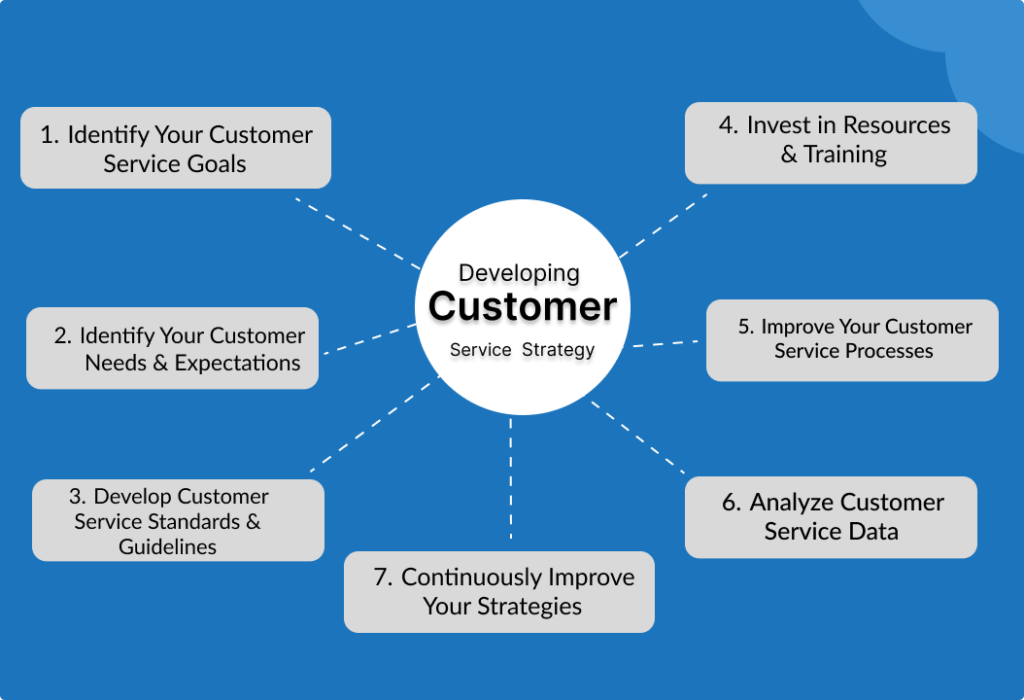Do you know what are the 7 steps to developing a customer service strategy? In today’s competitive marketplace, customer service is more important than ever. Consumers expect friendly, fast, and efficient service from the companies they do business with. Companies that fail to deliver may quickly find themselves losing customers to their competitors.
What’s a Customer Service Strategy?
Customer service is a comprehensive plan that a software development company has to ensure that its customers receive high-quality service. It involves identifying customer happiness and needs and setting service standards.
The company also provides resources and support to help customer service representatives meet those standards. Basically, creating customer service involves a set of guidelines made to ensure customer happiness at every touchpoint.
Read also: Proven Steps to Develop Effective GTM Strategy
7 Steps to Developing Customer Service Strategy

Let’s discuss what are the 7 steps to Developing Customer Service.
Identify Your Customer Service Goals
Determine what your customer service objectives are and align them with your overall business goals. Identify measurable goals that can be used to track progress and measure success.
Identify Your Customer Needs and Expectations
Gather feedback from customers to better understand their needs and expectations. Use focus groups, surveys, and customer analytics tools to identify trends. Cover the areas for improvement.
Develop customer service standards and guidelines
Develop a set of standards and guidelines that define what exceptional customer service looks like for your business. Make sure they are aligned with your business values and brand identity.
Invest in Resources and Training
Develop comprehensive training programs and resources for your customer service team. You need to provide ongoing support and resources to help employees improve their skills. It will help foster a culture of continuous learning and development.
Improve Your Customer Service Processes
Try to identify areas where customer service processes can be streamlined or simplified. Invest in technology solutions such as customer service software. This will help automate and improve service.
Analyze Customer Service Data
Try to establish a system for tracking and analyzing customer service data. Use key performance indicators (KPIs) to monitor and analyze progress. Identify your areas of improvement. Implement a process for regular reporting and analysis of customer service metrics.
Continuously Improve Your Strategies
The last step is to use customer feedback and data analysis to identify areas for improvement. Try to create a culture of innovation and continuous improvement. You need to conduct customer satisfaction surveys for a better understanding of customer needs. Regularly review and update the customer service strategy and goals.
Every business is different. There is no one-size-fits-all approach to developing a customer service strategy. These seven steps provide a general framework that can be adapted to meet your business’s and your customer’s unique needs. Try to choose and implement what’s best for your business.
Read also: Proven Steps to Develop Effective GTM Strategy
Why is Having a Customer Service Strategy Important?
With some interesting information, let’s discuss why a properly planned strategy is important.
- According to a survey by Esteban Kolsky, 72% of customers will tell six or more people if they have a satisfying experience.
- Qualtrics XM Institute did a study. According to this, 94% of American customers will recommend a company whose service they rate as “very good.”
- 67% of customers report terrible customer interactions experience as the reason for switching businesses. (Esteban Kolsky)
- A study by PwC found that 73% of people consider customer service an important factor in their purchasing decisions. So it means a good customer service experience is a key factor in customer loyalty.
- Social media is a crucial component of modern customer service strategies. A survey was done by Sprout Social. According to this, 90% of consumers have used social media to communicate with a brand. Companies that respond effectively and quickly to customer inquiries can build strong customer relationships.
- Mobile technology is changing the way businesses approach customers. With the increasing use of mobile devices, customers expect to access customer service through a mobile app or website.
- Some studies have also shown that customers value empathy in customer service interactions. When customers’ concerns are understood, they will likely have a positive view of the company and its product or service.
These are some of the reasons that we need to have proper strategies. Having well-planned and well-executed customer service strategies is essential for any business looking to thrive.
Of course, no customer service is complete without focusing on building and maintaining positive customer relationships. This means listening to their feedback, proactively seeking their opinions, and ensuring they feel valued. Regular outreach and loyalty programs can all help foster a sense of connection between your brand and your customers.
Benefits of Having a Customer Service Strategy
A customer service strategy is important for several reasons:
Enhanced Customer Satisfaction
A well-planned customer service ensures customers have a positive experience while interacting with the business. This leads to increased customer satisfaction. And if your customers are satisfied, it can result in more customers and repeat business.
Builds Customer Loyalty
When a business provides excellent customer service, it can help build strong relationships with customers. It leads to increased loyalty and customer trust. These loyal customers are more likely to recommend your business to others, increasing the likelihood of new business.
Improved Business Reputation
A business that provides high-quality customer service will have a good reputation in the market. This reputation can lead to a positive attitude and an increased customer base.
Increased Revenue
A customer service strategy focused on improving customer satisfaction and loyalty can lead to increased revenue. The satisfied customers will return to a business and make repeat purchases. This will increase your business sales and revenue.
Competitors Advantage
Strong customer service strategies can help a business stand out from its competitors in today’s highly competitive market. Providing exceptional customer service can be a key differentiator if you want to make a difference in the market.
Conclusion
To conclude, a well-defined 7 steps to developing a customer service strategy is essential for businesses to succeed in today’s competitive market.
Developing customer service strategies requires companies to listen to their customers, understand their needs, and align goals with business objectives. To execute the strategy, companies must invest in resources, streamline processes, and leverage technology to improve service.
Ultimately, by providing exceptional customer service, companies can set themselves apart from competitors and create a loyal customer base for long-term success. Indeed, Modern business that focuses on a customer-focused business landscape is a key differentiator in today’s world.
Remember! exceptional customer service isn’t just a strategy. It’s a mindset and a commitment to exceeding customer expectations consistently.
See More




